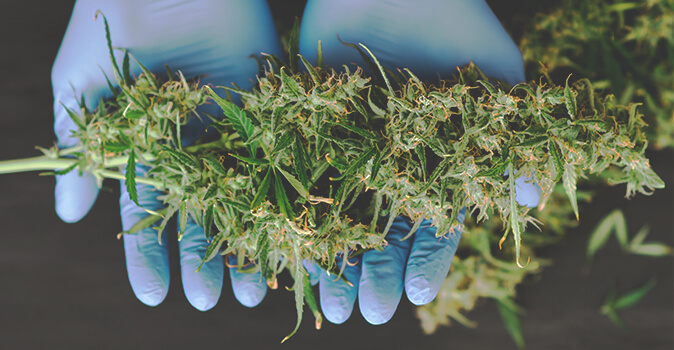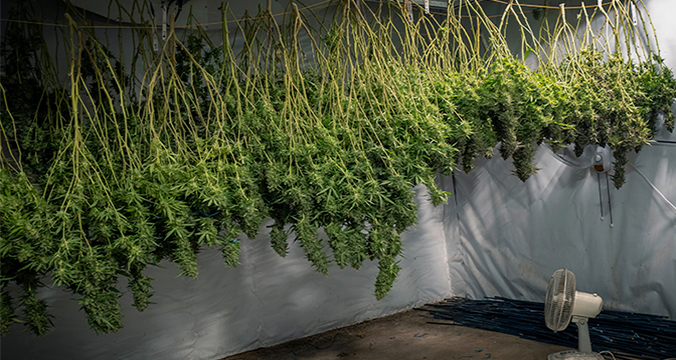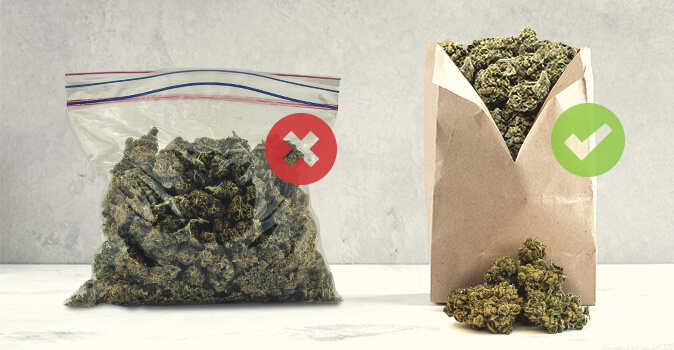How To Avoid Mouldy Buds When Drying And Curing Your Weed
Published : Jan 8, 2019

Mould is a problem that can occur during all phases of growth. But the risk for mould is even greater after harvest when you dry and cure your weed. You may think that your bud is safe in your jars, but before you know it, mould takes over and may destroy your stash. Learn how to avoid mouldy buds when drying and curing your weed!
It's finally time for harvest! After spending months keeping your precious cannabis plants healthy, battling pests and warding off disease, you are now eagerly reaping the fruits of your labour and dedication. The buds have turned out awesome: plump and juicy, they are tempting you with their enticing aroma—but you know that you cannot enjoy your rewards just yet.
Before you can finally set a light to your herb, you still need to dry and cure it. For this last part of the process, you need to be extra careful not to allow your excitement to take over and rush things. When you’re drying and curing your weed, it’s essential to prevent mould from forming. Otherwise, it could ruin your entire stash before you know it.

WHAT CAUSES MOULD?
Mould is really the bane of every cannabis cultivator’s existence. It can affect cannabis plants throughout all stages of growth, for example due to high humidity when exposed to rainy weather outdoors. Largely, what increases the risk of mould is moisture. And not just during growth, but post-harvest as well. In fact, the risk of mould propagating on your buds is at its peak during these final crucial steps of preparation. As such, it’s essential to remove excess moisture to mitigate any potential issues.
HOW TO PROPERLY DRY YOUR WEED
The key to properly drying cannabis is to allow it to dry slowly. Give the process plenty of time and do not use any "fast drying” methods. The reason for this is that any rushed methods can easily destroy the valuable cannabinoids and other active compounds in your crop.
Many cannabis cultivators hang their weed to dry, or place it on drying racks in a suitable environment. The ideal drying location for your cannabis should have low humidity and be out of direct sunlight. This will help to not only prevent mould, but also keep valuable cannabinoids and terpenes from degrading. A good place for drying can be a dark spare room or a closet. If you don’t have a suitable room to hang your buds up, you can also place them in a cardboard box.
For setting up a drying location for your buds, you can use a washing line, a sturdy rope, wire, or string. If you want to make a room of yours into a drying room, it can help to block light from the windows with curtains or blinds. You should also make sure that your grow area has good air circulation. This is another factor than can reduce the risk of mould. A simple standing fan may be all that’s needed to provide gentle airflow around the room. Just make sure that the air from the fan doesn’t directly hit your buds since this may dry them out too quickly. Remember, the longer your weed can dry, the better!
Use a hygrometer and a thermometer to check on the conditions of your drying location. Optimally, the relative humidity in your location should be about 50%, and the temperature should be about 20°C. If the humidity is off and you cannot use another spot for drying your weed, consider using a humidifier or a dehumidifier. As your weed is drying, make sure to check on it regularly for signs of mould.
Most of the time, drying your weed this way will require 7–9 days. You can use an old trick to check whether your bud is ready to move on to the final curing stage. Take a bud and slightly bend the stem. If the stem snaps, your weed should be sufficiently dry and is ready to be cured. If the stem is still soft and bendy, give it a few more days.

HOW TO CURE YOUR WEED SUCCESSFULLY
Now for the curing stage. Curing is the process where your cannabis will really develop its aroma and potency. Curing also ensures that any remaining moisture in the buds is evenly spread across your stash. Too much moisture would otherwise cause mould to grow, but too little will make your weed harsh, dry, and brittle. Let us look at several ways you can go about curing your weed properly.
CURING YOUR WEED IN GLASS JARS AND “BURPING IT”
The most common way many cannabis cultivators cure their buds is by putting the dried flowers into glass mason jars with lids. To provide your buds with just the right amount of humidity as they cure in the jar, what you need to do is “burp” your weed.
To burp it, you open the jar for about an hour or more every day to let the stale, humid air out. In the beginning of the curing phase, you should “burp” your jars 3–4 times per day. Know that burping your weed isn’t very accurate. This method requires that you check on your weed and burp it by hand. And this isn't always very reliable. In very humid conditions, for example, burping can actually reintroduce moisture to your weed.
Tip: When burping, you should also give the buds a gentle stir to allow air to circulate as much as possible.
The curing phase normally lasts 2–4 weeks. Once you feel as though your weed has sufficiently cured, you can now begin to enjoy your spoils, and can keep the jars consistently closed for long-term storage.
CURING WITH HUMIDITY REGULATOR PACKS
To make things easier and to take out the guesswork as you are curing your weed, you can use two-way humidity regulator packets. Simply add these packs into the jars along with your weed, and they will maintain the perfect relative humidity for curing.
Common brands of humidity packs are Boveda and Integra Boost. The packs are available with different RH maintenance levels, such as for 72% RH, 62% RH, or 55% RH. The optimal type of humidity pack for curing may depend on the type of herb and your personal preferences, but a 62% humidity pack is normally a good start for cannabis. You can find humidity packets online, in grow stores, and also in cigar shops.
CURING IN A PAPER BAG
Although glass mason jars with a lid are arguably the best way to cure your weed, you can also cure it in a brown paper bag. Paper bags can remove moisture from your weed, thereby minimising the risk for mould. Just make sure that you do not use a plastic bag! To cure your weed in a brown paper bag, place your buds inside, but don’t overfill the bag. Obviously, this curing method is not super accurate, so you’ll want to check back on your weed often so that you can spot any mould early.

WHAT IF YOU SPOT MOULDY BUDS?
The most important thing first. Do not, under any circumstances, smoke mouldy buds. Mould is bad for you and definitely not something you want to ingest in any way. If you spot mouldy plant matter at any point as you dry or cure your weed, immediately discard the mouldy bud. If you’re lucky, the mould may not have spread to your entire stash just yet. Closely examine your buds to see if you can spot any other signs of mould elsewhere. If you see anything suspicious and have any doubt, it is always better to discard your entire stash. Not great, yes, but still better than seriously risking your health!
HOW TO AVOID MOULDY BUDS WHEN DRYING OR CURING—THE TAKEAWAY
Growing cannabis plants successfully is just the first step on the way to awesome bud. A lot can happen, from bug infestations to problems with cannabis diseases or nutrients, before you can look forward to a bountiful harvest. But the drying and curing process after harvest is just as important so you can enjoy your hard work. If you stick to the the tips from this guide, you won’t lose your precious buds to mould after harvest.
Happy growing!


.jpg)




































